Home » Roofing Services
Category Archives: Roofing Services
Why You Should Trust a Residential Roofing Expert
Residential roofing is a key component of any building and is often overlooked. Trying to fix or replace a roof without the right experience is dangerous. Even a small blunder can cause significant damage. Regarding roof repair, maintenance, or replacement, it is best to trust professional residential roofing experts.
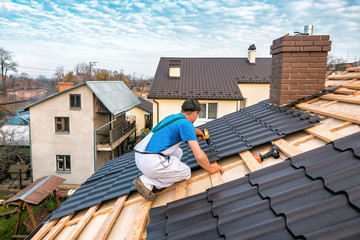
A reputable roofing contractor will follow safety guidelines and provide all necessary equipment. Roofers will also have liability insurance to cover any accidents on the worksite. In addition, they will ensure that all employees are trained and understand the importance of workplace safety. A roofing company that follows a strict code of conduct will likely be highly rated by its customers.
A brand-new roof is a major investment for a homeowner. It can increase the value of a home, improve its curb appeal, and protect the health and wellbeing of a family. However, homeowners should be aware of the risks associated with working on a roof, and hire an OSHA-trained roofing professional to perform roofing services.
Moreover, the roofing contractors should have an easy way to get to and from their jobsites. Ideally, they should be within walking distance to the home. This will reduce the risk of tripping or falling, which is a common cause of workplace injuries. Also, they should clean the work area regularly to avoid the tripping of debris or hazardous substances.
The roofing contractors should wear protective clothing while performing the job. This includes boots, gloves, and a helmet. The shoes should be hard-soled and have sufficient grip to prevent slipping on slippery surfaces. The helmet should be fastened securely to the head, and it should be well-fitting. The gloves should be thick enough to protect the hands from pricks and cuts.
Additionally, they should keep their ladders clear of all objects, and should not lean them against gutters or siding. These materials are not strong enough to support a ladder, and they may even deteriorate in the sun. The contractor should also check that the ladder is stable before climbing on it. If they find that it is not, they should move it to another location.
In addition to performing the roofing job, a good residential roofing contractor should also inspect and clean downspouts and draining systems to avoid flooding in the crawl space or basement. They can also replace or repair gutters that are clogged with debris. They can also help with drainage issues, such as those caused by a foundation wall leak or water infiltration.
A roof is an integral part of the home’s structure and value. It protects the interior from rain, sun and UV rays. It is difficult and dangerous to try to repair or replace it yourself without the help of a professional. Choosing the right contractor for your roofing needs will ensure that the job is done correctly and within an appropriate time frame.
Residential roofing experts are able to work on projects quickly and efficiently because they have the right tools and materials at their disposal. In addition, they take local weather conditions into consideration when calculating their estimated time frames for the project. This helps them deliver top quality results and minimize the impact on your daily life.
When you hire a professional, they will provide you with a written estimate of the cost and scope of the work. This will give you peace of mind that you are not being overcharged or taken advantage of. In addition, a contract protects both parties by clarifying the terms of the agreement and preventing disputes or lawsuits from arising.
Moreover, a trusted roofing expert will only use high-quality products that have been tested and approved for use in your area. They will also perform a complete inspection of the roof to check for any damage or problems. These companies can then recommend the best repair or replacement solutions for your roof. This way, you will be able to avoid costly repairs in the future.
Many shady roofing contractors will avoid giving homeowners an upfront, written estimate of the cost of the roof repair or replacement. This is because they want to take over the insurance claim and keep all the money for themselves. A reputable roofing company will never charge your insurance for things they did not do or even touch on the roof.
It is important to choose a local roofing company that has been in business for a long time and has established a solid reputation in the community. A reputable roofing company will have a large number of online reviews from multiple sources that google recognizes. These are a good indicator of the quality of their work.
The warranty offered by a roofing contractor is an important factor when choosing the right roofer for your home. Generally, a quality roofing company will offer warranties that cover both the material and workmanship. This will give you peace of mind knowing that your investment is protected in the event that something goes wrong. This will also provide you with confidence in the quality of their work.
The standard manufacturer’s shingle or roofing material warranty is usually 25 to 50 years, and will cover manufacturing defects in the materials. However, this does not protect against the weather damage that most homeowners experience. It is often necessary to upgrade a roofing material warranty to an extended warranty that offers additional coverage.
A roofing contractor’s workmanship warranty will usually last one to five years and will cover any leaks, failure, or defect in the roofer’s workmanship. However, the length of the warranty is less important than the intent and ability to stand behind the work. Some contractors will offer a longer warranty on their workmanship, while others may have specific stipulations in place that could void the warranty.
Typically, roofing material manufacturers will only extend their warranty protection to a roofing contractor that they trust to do an excellent job on their products. This means that the contractor must have a solid track record of flawless installations, and a reputation for being reliable and trustworthy. It is also a good idea to check that the roofing contractor has an established online presence. If Google recognizes them and they have a multitude of online reviews, it is likely that they are a legitimate company.
Most warranties will have stipulations that will void them if the homeowner does not follow maintenance requirements. For example, many shingle warranties will only be honored if the homeowner has it regularly inspected and maintained by a professional. This will help ensure that the roofing system stays in good condition and maximizes the return on the original investment. Many warranties will also void the coverage if the roofing system is altered in any way by another company other than the original contractor.
Residential roofing experts can help you with any kind of roof repair, maintenance, or replacement services that you might need. They can also help you with any insurance claims and other related issues. They can provide you with a warranty for their work and make sure that it is done right. Moreover, they will do everything possible to meet your needs and budget. Generally, they have years of experience in the field and will do an excellent job on your home’s roof.
A brand new roof is an expensive investment for any homeowner. Hence, it’s important to choose the best contractor for the job. A good way to evaluate potential contractors is by checking their online reviews and asking for referrals from friends or family members who’ve had similar projects. You should also ask about their credentials, such as whether they are licensed and insured. Moreover, they should have a strong track record and a long list of satisfied clients.
When it comes to performing roofing services, safety is always a top priority. Roofing is an inherently dangerous job, and many people end up getting injured or killed while doing it. This is why roofing specialists are trained to avoid these dangers and use the appropriate tools and equipment for the job. Additionally, they will have extensive experience working with different types of roofing materials and have an intimate knowledge of construction techniques and zoning regulations.
Roofing expert witness work is often required in legal cases involving roofing, waterproofing and building envelope systems. Consequently, the roofing consultants and construction experts at Bert L. Howe & Associates have gained extensive experience in the area of forensic analysis, site investigations, repair cost estimating and testimony for litigation practitioners, law firms, owners, general liability carriers, and construction practice groups.
Regular maintenance for your roof can protect it from damage caused by storms and normal wear and tear. EZ Management offers professional residential roofing services that can help you keep your roof in top condition and save money on costly repairs later. Their team can assess your roof and identify problems early, so you can fix them before they get worse. They can also provide regular inspections and maintenance to prevent damage and extend the lifespan of your roof.
Choosing the Right Commercial Roofing Materials
Keeping the roof of commercial buildings in good condition is key to preventing damage and reducing energy consumption. However, choosing the right roofing materials to meet these needs varies from customer to customer. Read on Roofing Columbus GA to learn more.
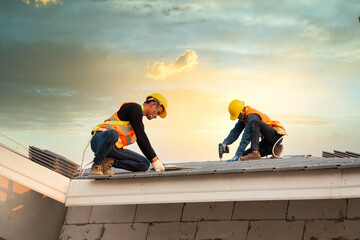
Commercial and industrial properties require different types of roofs. Unlike residential properties typically outfitted with shingles, most commercial structures are equipped with flat or low-slope commercial roofs.
Commercial roofing comes in various types to accommodate businesses’ different environments. Sometimes, roofs are categorized by the type of structure that sits on them like flat roofs or low slope roofs and other times they are grouped according to the roofing materials used to build them. For example, built up roofing (BUR) is a popular type of roof that uses layered asphalt and fabrics to form a durable membrane. Other types of commercial roofing are single-ply membranes that use rubber or synthetic materials. Some of these include EPDM and Thermoplastic Polyolefin (TPO).
Shingles are commonly seen on residential properties with steep roof lines but they also have applications for commercial buildings, especially those located in wooded or wet areas. There are many shingle options to choose from, including asphalt, architectural, ceramic and slate and they can be affordable and easy to install. However, their lifespan is shorter than some other commercial roofing types and they are vulnerable to mildew and moss when they are shaded.
Metal roofs are another type of commercial roofing that is popular for its durability and longevity. They can be made out of steel, copper or aluminum and have high fire resistance ratings. They shed snow and rain very well and can last up to 50 years with the right maintenance. The only drawback of a metal roof is that it can be prone to corrosion. However, there are now metal roofing systems that have protective surface layers that manage this risk.
Another popular option for commercial roofs is rubber or PVC. These are single-ply membranes that are chemically adhered to the insulation on some commercial facilities. These are relatively inexpensive and durable. They have a wide range of color options to add style and are highly resistant to UV and heat.
Another benefit of these types of roofs is that they are very energy efficient. They can help reduce a building’s cooling costs by reflecting the sun’s rays. They are also lightweight and puncture-resistant. The only downside is that these roofs are more expensive than other commercial roofing options.
There are many different types of materials that can be used in commercial roofing. Some of these include single ply membranes, asphalt shingles, concrete tile, wood shakes and slate. The type of roof will dictate the type of material that is used. For example, a steep sloped commercial roof will require a specific type of roofing material that is designed for those type of slopes.
A single ply commercial roof membrane is generally made of rubber or plastic. These are manufactured in a factory and can be installed on the roof using one of several methods including fully adhered, mechanically attached or ballasted. Single ply commercial roofs are extremely durable and offer excellent resistance to weathering, punctures or tears, and bacterial growth. They also are highly reflective, helping to reduce energy costs in the building. These commercial roofs are also easy to repair and maintain.
EPDM is a popular type of single ply commercial roofing that is available in various colors and has a long lifespan. This durable roof membrane offers good flexibility and can handle structural fluctuations better than other flat roof options such as TPO or PVC. It is also fire rated and has excellent air and water resistance.
Another popular type of commercial roofing is a metal roof. These roofs are typically comprised of galvanized steel, aluminum or copper and are designed to be both waterproof and durable. They also have the added benefit of being able to be integrated with snow removal and solar systems.
Modified bitumen (MB) is a common type of low-slope or flat commercial roofing. It is constructed from a layer of reinforcing fabric that is covered with an asphalt mixture. This is then covered with a gravel layer to help provide extra protection for the roof. This is a tough roof type that can withstand a variety of temperatures and can last for up to 20 years.
A silicone roof coating can be rolled or sprayed on to provide a protective layer for a variety of commercial roof types. This includes tar and gravel roofs, single ply membranes, as well as EPDM. The key benefit of a silicone roof coating is that it is highly resistant to ponding water. This is a common issue that can occur on some flat or low-sloped commercial roofs and is often caused by improper drainage systems.
When replacing a commercial roof, the goal is to provide the business with a sturdy structure that protects contents and occupants from rain, snow and debris. In addition to the structural integrity of the building, many regions have stipulations regarding energy efficiency which must be taken into consideration when choosing a new roof.
The type of roofing chosen is important, as is the installer. A reputable roofing company will work with you to find the best solution for your building and its use. For example, a restaurant will have different needs than a jewelry store. A local roofing contractor will have experience in the various types of roofs and be familiar with any stipulations that may affect your specific region.
Some of the most common commercial roofing systems include single-ply membranes, concrete, modified bitumen and built-up roofing system (BUR). The single-ply membranes such as TPO and PVC offer durability, low maintenance and cost effectiveness. They are also highly reflective and can help reduce cooling costs. The built-up roofing system, with a tar and gravel coating, is an older low-slope roof that offers flexibility and can be adapted to specific building requirements.
Depending on the type of roofing, the installation process can take between four and 12 days. The amount of time will depend on the size and complexity of the project, as well as weather conditions. In addition, the permit process can often cause delays. A good roofing company will work diligently to avoid any unforeseen delays, but they cannot control everything.
A key aspect of a quality commercial roof is proper ventilation. If this is not addressed, a roof could leak or become damaged over time. This can lead to costly repairs or even the shutdown of a business. To prevent this, a roofing contractor should inspect the roof for adequate air flow and proper insulation.
Both residential and commercial roofs need regular maintenance. A professional roofer can help maintain the health of a roof by removing any debris from gutters and downspouts. They can also make sure that all eavestroughs are open and free of obstructions, which can cause water to back up into the roof and damage the interior.
The commercial roof is one of the most important investment that property owners make in their structures. It protects the occupants and contents from outside elements, and is crucial to the building’s energy efficiency. Unfortunately, the roof is often neglected. Many owners only think about it when a problem arises, such as leaks or interior damage.
The best way to ensure that the commercial roofing system will continue to perform properly is to create a preventative maintenance plan with a local professional roofing contractor. Keeping up with the plan will save money, minimize costly repairs, and extend the life of the system.
An effective preventative maintenance program should include visual inspections, gutter and drain cleaning, debris removal, small repairs, and a full roof survey. It should also include recording the results of each visit and providing photo documentation. This will help to identify the cause of the problem and provide the building owner with a clear picture of the condition of the roof.
A commercial roofing expert will be able to determine the appropriate level of repair, from minor repairs to replacement and/or re-roofing. The expert will be able to provide recommendations based on the age of the roof, the current condition, and use of the building.
Inspecting the entire roof for any signs of damage or general wear is critical to avoiding expensive repairs. A thorough inspection should include looking at the following:
Deterioration of sealant – This is usually the result of long term exposure to weathering. Common areas of concern are above pipe boots, metal flashing details, gulleys, and termination bars. Commercial roof maintenance will inspect these areas and re-seal as needed.
Drainage issues – This can be caused by the accumulation of water, debris, or improper slope and drainage. If left unchecked, these issues can lead to ponding water and degrade the roof membrane. Commercial roof maintenance will check for clogged gutters and drains, sagging drains, or damaged ponding areas.
A commercial roof should be inspected on an annual basis to avoid problems. A good roofing company will be able to provide a written report with photos, discuss any issues found and recommend the next steps. A regular maintenance schedule will also help to extend the life of the roof and keep it under warranty.
What Do Roofers Do?
Roofers keep our homes and other buildings safe from the elements. Their work involves repairing or replacing roofs made of tar, asphalt, gravel, rubber, thermoplastic, metal, and shingles. Some roofers specialize in a particular type of roofing, such as solar shingles or green roofs. They also install insulation systems and vapor barriers.

Roofers install and repair the roofs of residential and commercial buildings. They are skilled tradespeople who follow construction plans and perform roofing in accordance with them.
A job description is a detailed document containing important information about a job opening. It includes the qualifications and skills that are required for a person to qualify for a job position, along with other details such as how much remuneration is offered.
The primary purpose of a job description is to attract candidates and select those who are most qualified for a job. However, it also serves other functions such as supporting training and development activities and justifying an employee’s pay.
A successful job description consists of a strong job title, a clear and concise purpose, the responsibilities section, an outline of hard and soft skills, and specific details about working conditions. A good job description successfully attracts suitable candidates and deters unqualified jobseekers. It’s the best way to attract and retain top talent, so make sure yours is thorough yet concise.
Education and training requirements. Roofers are trade professionals who install, repair, and maintain the roofs of different types of buildings. They work with a variety of materials, including metal, shingles, and slate.
They assess the condition of roofs, identify and fix leaks or rough spots, and remove debris from roofs and gutters. They also receive training about job site safety.
To be a roofer, you need to have a high school diploma or equivalent and experience working with construction equipment. You can also earn a degree in the roofing industry or get an apprenticeship.
Depending on your state, you can choose to work under the supervision of a licensed roofing contractor or become certified by the National Roofing Contractors Association. This can help you stand out in the marketplace and increase your earning potential. It’s also important to stay up-to-date on the latest roofing techniques and products. You can attend continuing education classes and professional associations to keep up with industry developments.
Work environment. Roofers install, replace, and repair roofing systems on homes and commercial buildings. They use a variety of materials, including shingles, tiles, slates, and bitumen.
This career is physically demanding. It requires climbing high onto roofs and working with heavy or large materials. It also requires handling hot bitumen, which can cause burns and injuries.
As a Roofer, you wear clothing designed specifically for the job, such as hard hats and eye protection. You also wear thick-soled shoes, which provide a better grip for roofing material and help you stay cool while working on hot roofs.
A high school education or its equivalent is a prerequisite for this occupation, but you may need an apprenticeship to gain the proper training and qualifications. During your apprenticeship, you learn about all the best practices in this industry, as well as the most technologically advanced tools and techniques available. Those who have completed their training can move on to supervisory or management positions within the roofing industry.
Job outlook. Roofers install, repair, and replace roofs made of a variety of materials, including tar, asphalt, gravel, rubber, thermoplastic, metal, and shingles. They also provide advice on roofing types that meet the needs of a building, taking into account local weather and cost.
The job outlook for roofers is generally good, and employment is expected to grow by 11% through 2026. This is above the overall projected growth for all tracked occupations in the U.S.
Workers in this career are typically self-employed, but they can work for contractors as well. They may contact employers directly or use job leads from vocational schools or online employment sites.
This career is physically demanding, with long hours spent outdoors and working at heights. However, it offers a high income and opportunities for advancement into leadership positions. A strong work ethic and desire to advance are essential for this career. It is also a good fit for those who like a work-life balance.
What You Need to Know About Roof Installation
When you are looking to install a roof on your home, you need to consider many things. Different materials can be used in the process, including Slate, Metal, and Shingles. These can be very expensive, so you need to know what you are getting into before you begin.
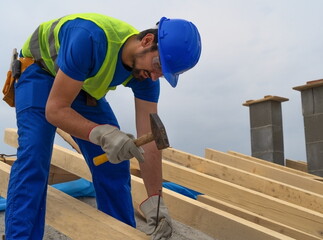
There are a lot of different types of underlayment for roof installation. Choosing the right one can be a challenge for homeowners without technical knowledge. However, professional Roofing can help you choose the best type of underlayment.
Whether you have asphalt, metal, or wood roofing, you’ll need to use an underlayment to prevent moisture from getting underneath your shingles. Choosing an underlayment that is waterproof and can withstand the amount of traffic your roof is likely to get is important.
Using the wrong underlayment can cause your roofing deck to warp. You should also take care to choose a high-quality underlayment that has a heat resistance. Several underlayments are tested to withstand heat up to 250 deg.
If you are planning on building a roof in a region with cold weather, you may want to consider a rubberized underlayment. These are designed to seal around the fasteners and are a more durable barrier against water leakage.
Roof shingles are small segments of material that are used to cover the roof’s surface. Shingles are available in a variety of materials, colors and styles. They are typically installed over a layer of underlayment or a flat roof surface. The installation method for shingles will vary by manufacturer, so be sure to consult the manufacturers installation manual.
Depending on your local climate, you may want to choose between wood shingles and metal shingles. Metal shingles are lightweight and have a long life span. You can lower your cooling costs by choosing metal shingles. However, they can be susceptible to rot, fire and hail. Wood shingles, on the other hand, are vulnerable to chipping in the Great Plains and are not recommended in rainy climates.
One of the most important aspects of a good shingle job is the proper placement of nails. Nails should be placed about one inch from the edge of the shingles. A pneumatic nail gun generally drives nails, but you can also use a hammer.
If you are looking to add some style and substance to your home, consider installing a metal roof. Metal roofs are not only durable but also incredibly energy efficient. They absorb less heat and reflect more sunlight.
While metal roofing systems may not come with a typical warranty, you can expect your new roof to last at least 50 years or more. In addition to protecting your home, a properly installed metal roof can also increase your property’s value.
You will need the right tools and materials to install a metal roof on your own. You may be able to save some money by doing it yourself, but hire a professional to ensure you get it right. It’s also important to check your insurance and licenses to see if they are up to date.
The first thing you should do is measure your roof. This will help you determine what materials you need and how much it will cost. Once you have the numbers in front of you, you can start shopping for the right materials.
If you want to install a slate roof on your home, there are several things you need to know. It’s important to get professional advice before you start. There are several types of slate roofing, and not all of them are created equal. Some are more expensive than others. You should also research the warranty of your roof.
Slate can be installed by professional contractors or by do-it-yourselfers. Make sure the contractor has the necessary skills and tools to complete the job. A properly installed slate roof will last for years. However, it is still possible for mistakes to occur. These are difficult to correct.
The installation process begins with chalking the courses on the roof deck. Then, you need to lay the starter slates back-side up. This will allow the edge bevel to merge with the first course. In addition, it’s important to use good nails. For this, copper is usually best. Electro-galvanized nails are not recommended. They can weaken the nail hole and cause the course above to lift.
Types of Roof Repair
When it comes to repairing your roof, there are several things to consider, and one of them is the type of materials you choose to use. Knowing the different types and materials available and their prices is important. You can find the best roofing material for your home by comparing the different options.
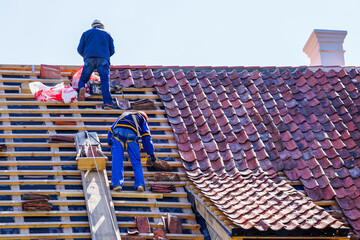
Identifying the damage to your roof is an important part of roof repair. It is a good idea to take the time to identify the damage to your roof to protect your home and to keep your family safe. Having a qualified professional inspect your home will help identify any problems and can prevent further damage to your property.
While it may not be the first thing you think of when considering your home, your roof can be one of the most vulnerable parts of your house to storms. Storms can cause a number of issues, including leaks, rot, and mold. If you’ve recently experienced a storm, be sure to check your roof for any damage.
The most obvious sign of damage is missing shingles. Other signs include broken tiles, mold, and even moss. However, identifying the damage to your roof can be tricky, especially if you are not an expert in roofing.
Fixing the leak. A leak in the roof can ruin the structural integrity of your home. The best way to fix a leak is to call an experienced roofer or contractor. However, if you’re a do-it-yourself homeowner, you can also fix your leak without the help of a professional.
Before you can make any repairs, you must know where the leak is coming from. A leak can occur anywhere on your roof, but the most common place to find it is in the attic. You can use a flashlight to locate wet spots on the rafters and sheathing.
Once you have found a spot where the leak is coming from, you can use a small hose to isolate it. Run the water for a few minutes in one area.
Repairing a dormer on a roof. A dormer is an extension of your roof that can be used to create extra headroom in your home. It can also be a decorative addition. However, dormers are prone to weather damage. Therefore, you should make sure to fix any issues as soon as possible.
One of the best ways to prevent leaks around dormers is to ensure that the area is properly flashed. If the flashing isn’t installed correctly, water can easily get underneath the shingles and cause major problems.
Another way to avoid leaks is to install a spot sprinkler on your roof. This will mimic rainfall, and it can be plugged into a garden hose so it can be turned on when you need it.
You should also replace any cracked caulking on your dormer. Peel and stick flashing tape can be helpful, too. These seal areas that are hard to get a good seal.
A rafter tail is the exposed end of the rafter. These can be used as a soffit system or as a decorative feature below beams. They are typically scrolled or detailed and extend beyond the structure’s exterior wall.
If you have a rotted rafter tail, you can either replace it with new wood or remove it from the roof. You can use a reciprocating saw to cut away the rotten section of the rafter.
First, remove the underlayment from the rafter to replace a rotted rafter tail. Next, cut the roofing nails on the top of the rafter. This will enable you to fasten a new board to the old rafter.
You will also need to drill into the end of the rafter. Using a screw-tip attachment on a cordless drill, drive a 2-inch deck screw through the upper edge of the rafter tail at 4-inch intervals.
Mansard Roofs
Roofing is the top covering of a building and includes all materials and constructions that support it. It is an important feature of a building, as it protects the building from weather elements and acts as part of the building’s envelope. In the States, mansard roofs are common. They are more stable than other types of roofs and can last for 75 years.
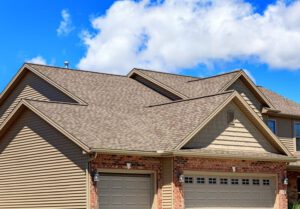
The materials used for roofs come in a wide range of types. Some are lightweight, while others are heavy and durable. Concrete, for example, is commonly used for roofing. Another option is fire-retardant wood, which is relatively inexpensive and robust. Steel, on the other hand, is extremely light but is the most expensive option.
Metal roofs are popular in warmer climates, as they reflect heat. They’re usually installed in large panels, making repairs easy. If a panel is damaged, you can patch the hole with a waterproof sealant, so you don’t need to replace the whole panel. Metal roofs are also extremely practical and durable.
Roof decking provides extra support and structure for roofs. Unlike the exterior roofing material, this material is not visible from the inside of a building. It also helps regulate air circulation inside the building. Common types of decking include wood, concrete, steel, and rubber. These materials are used for a variety of roofing applications, including flat roofs.
Roofing materials can range from traditional materials such as clay and slate to new materials. Many homes use asphalt shingles. These materials are inexpensive, durable, and easy to install. But there are many pros and cons to choosing a different material for your home. If you’re considering replacing the roof on your home, consider all the options available to you and weigh the pros and cons of each one.
Another common roofing material is bituminous waterproofing underlayment. These layers of asphalt-impregnated paper and felt protect the roofing material from water damage. Often, roofing systems include multiple layers, including clay tiles, which require an underlayment. The underlayment helps control water drainage and also provides insulation from heat sources.
Clay tiles can offer a unique aesthetic to a construction project. They are also one of the most sustainable roof materials available. They are extracted from clay pits, fired, and glazed to create a long-lasting roof. And they’re 100 percent recyclable, which means you can reuse them for many years.
Wooden roofs are also a popular choice and are traditionally used on ranches and bungalows. Although they can cost a bit more, they are a great option for homes. The most common types of wooden roofing are cedar, redwood, and southern pine. These roofs generally last for about 25 years but can be costly.
Pitched roofs are stronger and more stable in heavy rain than flat roofs. They also offer better drainage. Because the water drains off easily, it doesn’t build up and create structural pressure. The steeper angles on a pitched roof also guide rain and snow away from the building, minimizing the risk of water damage. This means that a home built with a pitched roof is more weather resistant and less expensive to repair.
Pitched roofs are characterized by one rafter with an inclination of at least 45 degrees. They’re the most inexpensive to build and the simplest to install. Builders often try to make the incline higher than 45 degrees to provide better drainage. Common structures with this type of roof include lean-tos and sheds. They’re also commonly used on cabins in the mountains.
Pitched roofs also require less maintenance than flat roofs. A pitched roof will not need to be repaired as frequently and can be maintained for over 100 years. Another benefit is that they’re environmentally friendly. Natural slate is one of the most durable roofing materials, lasting for hundreds of years.
A pitched roof is more stable than a flat roof during heavy rain because it provides better drainage. When rain falls on a flat roof, the water can build up and cause structural pressure. A single-pitched roof is also known as a shed or pent roof. It has one slope and is attached to a taller wall. This type of roof also offers additional storage space.
Pitched roofs are also better for regulating the temperature of a building. Pitched roofs have more space for natural ventilation between the flat interior and outer roof. This helps maintain the temperature of the interior space while eliminating damp air from the roof during winter and letting hot air escape during the summer. Flat roofs require special materials and techniques to keep them waterproof. A pitched roof is generally used in commercial buildings.
Types of Solar Roofing
If you’re considering installing solar roofing on your home, you have plenty of options. You can choose between different types of solar panels and a micro-inverter to optimize your power output. These solar panels also come with battery backup, so you can use them even if there’s a power outage.

Solar roofing offers several solar roofing solutions, including photovoltaic cells. Each system is custom-built for the homeowner’s roof, and the company handles all permitting and other paperwork. However, because the systems are complex, it is recommended that you hire a licensed electrician to install them.
The solar shingles from Solar come with 16 monocrystalline cells and can generate an output of 80 watts. Their stated energy efficiency is 21%, making them significantly more energy efficient than conventional solar panels. They are also durable and come with several battery storage options for use during storms and power outages.
Solar is an experienced innovator in the solar industry. It has designed and created solar shingles that set the industry standard. The company has also partnered with manufacturers of solar batteries/storage to ensure that their systems work together seamlessly. As a result, Solar systems are a little more expensive than traditional solar systems. The process is also specialized and requires unique training and skill.
Solar Roofing’s roofs are backed by a 25-year warranty covering the power output and a five-year product warranty for material and manufacturing defects. Some Solar roofs have survived multiple hurricanes and hail storms. And they are upgradeable, so they can be changed as new technology becomes available.
The cost of solar roof shingles varies from $4.50 per watt to $38 per square foot, depending on the size and complexity of your system. The cost depends on the number of solar panels you want, your energy usage, and how much sunlight you get each day.
When it comes to solar roofing, there are several options available. GAF Energy is a company that is part of Standard Industries, the largest manufacturer of roofing materials in the world. This company’s solar roofing solutions are both energy efficient and environmentally friendly. They are also an excellent choice for homeowners who want a roof that will last a lifetime.
One advantage of GAF Energy solar roofing systems is that they are less noticeable than traditional solar panels. Traditional solar roofing systems are prone to attracting insects, animals, and other pests because of the exposed wires. With GAF Energy solar roofing, however, the panels are flush with the roof and don’t leave any gaps for moisture and pests. This allows the product to be more durable and to fit in with the minimalist look of the home.
The average American household emits 5.43 gigatonnes of carbon dioxide yearly. By installing a GAF Energy Solar Roof System, you can help reduce this pollution and save money on energy bills. In addition, you may qualify for special tax credits. Additionally, solar energy is also a renewable source of energy.
GAF Energy solar roofing products are made in a 130,000-square-foot manufacturing facility. The facility is capable of making solar panels for 8,300 homes each year. Each solar panel produces about 6kW of electricity. These panels are designed to last for years. GAF-certified contractors offer comprehensive warranties.
Solar roofing is a great choice for homeowners looking for a durable and low-maintenance roof. Unlike traditional solar panels, which require drilling holes into the roof and fastening racks onto shingles, Solar panels can be installed on a clean roof deck without the need for any repairs or maintenance. Panels have a built-in interlocking system that fastens directly to the roof deck and not to the rafters. The integrated interlocking system also makes it easy to install without a contractor getting on the roof. This helps prevent water intrusion and helps saves time.
Roofing Contractors
Roofing contractors are not required to be licensed and do not have to carry liability insurance or workers’ compensation insurance. They estimate the cost of each job. Building maintenance staff may not know what to look for or may have other duties. They may not have the time to climb onto the roof to check for problems. The best way to detect a problem with a roof is to call Roofing Contractors Wisconsin.
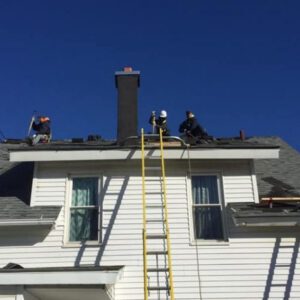
If you are thinking about hiring a roofing contractor, you may wonder if they need special licensing to work in your area. While most states do not require special licensing for roofing contractors, some do require them to register with the state. This board regulates all construction activities in the state, including roofing. It requires roofing contractors to obtain licenses from the state before bidding on projects. You must also register with the state’s Division of Revenue and be covered by workers’ compensation insurance.
Roofing contractors are required to be licensed by the state’s Board of Building Regulations and Standards, and if you are doing any roofing work on a structure with asbestos, you need a Construction Supervisor License. While there is no exam for the Construction Supervisor License, you should have at least three years of experience to qualify for this license.
Roofing contractors must register with the Division of Revenue and may need Asbestos Abatement Certification. Additionally, you may be required to attend additional education through the Roofing Contractors Association. It requires contractors to obtain a contractor license through the Department of Business and Professional Regulation. Roofing contractors must obtain a contractor’s license from the State Construction Industry Licensing Board.
Some states do not require roofing contractors to have a special license. But in most cases, you’ll find that the consequences of failing to obtain a license are far worse than the cost of a permit. Using an unlicensed contractor may put your property at risk and lead to fines and even termination of your project. In some cases, an unlicensed contractor may even face jail time. But even in these situations, you may be left with no recourse.
While you don’t need special licensing for roofing, you should check with your local licensing authorities. Some states require roofers to have worker’s compensation insurance. You might also wish to consider joining a contractor association.
When it comes to insurance for your roofing company, you may be wondering if you need liability or workers’ compensation insurance for your roofing company. These types of policies protect your business from high medical costs caused by work-related accidents. In a typical scenario, workers’ compensation covers the cost of medical treatment for employees injured in the course of business operations. For example, if a roofing worker accidentally nails his hand, this policy will cover the costs of a trip to the hospital and an X-ray.
The benefits of this type of insurance are clear: you can choose to accept these benefits immediately. However, if you decide to opt for workers’ compensation benefits, you’ll forfeit your right to pursue a lawsuit or collect punitive damages. It may be a good idea to have workers’ compensation insurance to protect your assets, employees, and clients.
In most states, workers’ compensation insurance is required for construction businesses. This policy is not required for roofing contractors, but other contractors are allowed to pay into a statewide program that offers this coverage. You should contact your state’s department of insurance to determine what types of policies are available and how to obtain them.
Another factor that affects a roofing contractor’s pricing is the number of employees needed to complete the project. A roofing contractor’s overhead cost includes office rent, uniforms, and insurance. In addition, contractors must account for additional expenses such as underlayment and labor. These costs can also be increased by complicated roof shapes or multiple layers of shingles. Also, weather conditions can affect the cost of labor. If the weather is bad, the team may need to tarp the roof and pay overtime to make up for a lost time.
Roofing Repair – Tips For Homeowners
If you suspect that your home’s roof needs repairing, it is a good idea to hire Roofers for the job. Although you can do simple repairs yourself, a complicated job may require the help of a roofing professional. If you are unsure of your abilities, call several roofing contractors to get quotes. There are many ways to make repairs to your roof, from replacing damaged shingles to replacing rotting flashing. Here are some tips to help you with your roofing repair project.
One of the simplest and most affordable ways to fix your roof is to re-roof it. Unlike many other types of roof repair, you don’t need to take the entire roof apart, which can cause more damage. In addition, you can even use the same shingles and trim on the same roof to match the look and feel of the old ones. The most common types of roof repair involve replacing broken or missing shingles.
While you may have sufficient knowledge of roofing repair and its materials, it’s best to hire a professional. Professionals can carry out these tasks more efficiently than amateurs, so it’s a good idea to get your roof inspected regularly. Even if you don’t have an emergency situation, regular scheduling inspections can prevent roof damage. Search for quality roofing repair services on the internet, or contact a company in your local area.
Intense hailstorms can quickly damage gutters and allow water and humidity to leak into your home. In turn, water and humidity can grow on your roof’s exterior walls and ceilings, leading to mold. This mold in your home can lower the air quality and even cause allergy-like symptoms. You can expect to spend anywhere from $700 to $4000 to get your home repaired after a hail storm. Check with your insurance company to determine if they cover the cost of repair.
You may be able to claim your homeowner’s insurance for the cost of the roofing repair. Generally, repairs caused by everyday wear and tear are not covered by your insurance. However, in the case of a significant storm or fire, you may be covered under the policy. However, you might be responsible for paying a deductible. And it’s possible that your coverage will lapse after a certain period. That’s why it’s important to get a professional for your roofing repair work.
You should check the condition of your shingles every few months to avoid further damage to your roofing system. Identifying problems with your shingles early on can prevent them from escalating to more serious ones. Another common cause of leaky roofs is the fixtures. Damage to the sealant or flashing around the fixtures can cause leaks in your roof. If you suspect that your roof is leaking, you should immediately contact a roofing contractor for repairs.
Whether you need a roof patch or a complete roof replacement, a professional is essential for the job. Roofing repair involves patching holes, replacing damaged materials, and replacing damaged roof parts. In order to properly determine what is wrong with your roof, you should inspect it from the ground. Broken or missing shingles, holes, punctures, and nail pops are all indications that a problem exists. Cracked flashing and granule loss are also signs that your roof may need repair.
Before hiring a roofing repair company, it is important to choose the type of roof you have. Asphalt is the most common type of roof, but other options include metal, composite, tile, shake, flat, and slate. Generally speaking, the most expensive type of roof to repair is asphalt. However, if your roof is made from slate, tile, or wood, you’ll have to pay more for the repair. Roofing contractors should have experience with each of these roof types and know how to use the right materials to repair and replace them.
How to Find The Best Roofer
When it comes to roofing, there are a few different tradespersons who specialize in this field. Roofers install, repair, and replace roofs. They use a variety of different materials to complete the job. Listed below are some tips for finding the right Roofer for your home. Listed below are just a few examples of jobs that roofers perform.
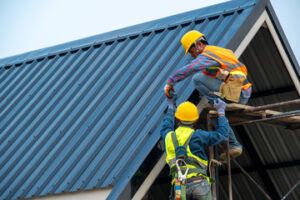 Roofers work on a variety of construction projects, including new installations. To get started on a new roof or repair an old one, roofers must have some carpentry skills. Roofers can replace old materials with new solid structures, such as shingles, wood, and asphalt shingles. Roofing Companies works with different materials, including plywood and metal. In addition to installing new materials, roofers can install vapor barriers and layers of insulation and use various other materials to make the assignment waterproof.
Roofers work on a variety of construction projects, including new installations. To get started on a new roof or repair an old one, roofers must have some carpentry skills. Roofers can replace old materials with new solid structures, such as shingles, wood, and asphalt shingles. Roofing Companies works with different materials, including plywood and metal. In addition to installing new materials, roofers can install vapor barriers and layers of insulation and use various other materials to make the assignment waterproof.
Whether working for a company or a homeowner, roofing professionals need to be physically fit and have excellent balance to prevent falls. They must also be detail-oriented when handling materials, such as shingles or slates. As a result, roofers need excellent hand-eye coordination and strong manual dexterity. Roofing jobs require extensive manual dexterity. They must also be able to use tools, measure accurately, and work in tight spaces. In addition, roofers must be physically fit, as they spend long hours standing on their feet and in hot temperatures.
Most roofs have multiple layers of materials, but low-slope roofs typically contain one layer of asphalt shingles. This means that roofers must be extremely careful to choose the right materials for the job. In addition, roofers can apply “green” roof systems that include a waterproof membrane, root-proof barrier, and soil for plants. Roofers must ensure that these systems remain watertight and that the roof is sturdy enough to support the weight of the soil.
Roofing materials also include asphalt shingles, metal roofing, and wood. These materials protect buildings and their contents. A leaky roof can cause water damage to your walls, ceilings, and furnishings. Roofers also perform reroofing, replacing an old roof on an existing building. They use power nailers to secure the materials. However, some prefer hammer and nail roofing because it gives them more control. You can even request them to repair your existing roof if needed.
Roofing is a great career choice for those who like physical labor and detail. Many Roofers choose to work for themselves as freelancers. While you might be able to work for a large construction company full-time, most jobs require physical labor. Some jobs require working in harsh weather conditions, such as hailstorms. If you enjoy the physical side of your job, you can even start your own roofing company. This job requires more experience and a more competitive salary.
Most residential steep-slope roofs are covered with shingles. To lay these shingles, roofers first place 3-foot-wide strips of roofing felt over the entire roof. Then, they nail overlapping rows of shingles to the roof. Roofers measure and cut the shingles and felt to fit the roof’s angles. They also use metal flashing strips at the corners of chimneys and vents to ensure they are watertight. Roofing cement covers exposed nail heads to prevent water from leaking in.
Roofing contractors use tools such as a hammer, utility knife, and ladders to reach roofs. In addition, roofers use power equipment like hammers and nails to remove old roofing systems. Roofing contractors also use utility knives, crowbars, and hammer tackers to complete the job. These workers also use a tape measure and level to measure the roof’s slope.
While the work is physically demanding, roofing contractors are compensated well. Apprentices start out earning about 50% of what journey workers make. However, they will eventually earn more as they advance through the apprenticeship program. With a high-paying field and a growing number of new construction projects, the job outlook for roofers is bright. The industry is projected to grow by 12 percent between now and 2028. It is predicted that the demand for roofers will continue to grow, even though this growth will be slower than average for all occupations.
Depending on the area of focus, roofers can work in either residential or commercial buildings. Because they must be skilled and safe, roofers can work for both specialty roofing companies and general construction companies. However, roofing contractors must be licensed and display their license number on their marketing materials. The requirements vary from state to state, but most licensed roofers can handle most residential roofing projects. They also have experience with tile, concrete, clay, and lead roofs.